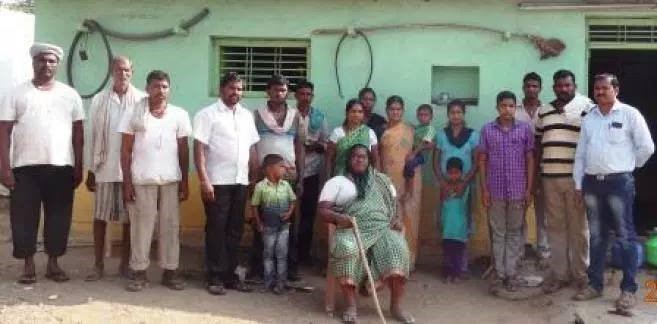Kavita Chohan
 There is a false perception among Indians that Dr. Ambedkar’s work addresses the concerns of Dalits and Dalit women only. This perception is not only found among those from “upper” castes, but also within the Scheduled Tribes, Other Backward Classes and women from the “upper” castes. Thus, the legacy of Dr. Ambedkar is claimed largely by Mahars and seems to remain unacknowledged by other sections of society. This article explores the origins of this false and limited propaganda that severely limits Ambedkar’s thought legacy.
There is a false perception among Indians that Dr. Ambedkar’s work addresses the concerns of Dalits and Dalit women only. This perception is not only found among those from “upper” castes, but also within the Scheduled Tribes, Other Backward Classes and women from the “upper” castes. Thus, the legacy of Dr. Ambedkar is claimed largely by Mahars and seems to remain unacknowledged by other sections of society. This article explores the origins of this false and limited propaganda that severely limits Ambedkar’s thought legacy.
Ambedkar has said that “I measure the progress of a community by the degree of progress which women have achieved”. He does not say that he measures the progress of the community by measuring the progress of Dalit women–he is addressing all women. Even then, one does not find Dr. Ambedkar’s name in the list of feminists cited by Indian feminists. The reason for this is simple—caste hegemony never allows a universal, egalitarian identity to a Scheduled Caste person. Throughout his life, Dr. Ambedkar fought for the rights of Indian women. He was instrumental in proposing the Hindu Code Bill in the parliament and expressed his urgency in reforming the status of Hindu women. However, it was the “upper” caste women who opposed the bill, without having understood it fully, and demonstrated in front of Dr. Ambedkar’s house. The caste system has not allowed Dr. Ambedkar’s thought to reach the masses. His work has been deliberately silenced, as can be seen from the unavailability of his books in the market and absence of his work in the educational curriculum.
By controlling the sexuality of their women, “upper” castes have always restricted their women’s freedom to choose her life partner, and also the freedom of widows to marry again. Through his analysis of surplus men and women, Dr. Ambedkar elucidated how the casteist patriarchy does not serve the interests of “upper” caste women as well. Instead of acknowledging his contribution to the feminist egalitarian thought, people are seen to make arguments that Dr. Ambedkar was not good to his wife Ramabai or that he did not care for the rights of the Scheduled Tribes and called them savages. Why is it that Ambedkar’s identity is reduced to that of a Dalit leader and the drafter of the Constitution? Why is his contribution to the larger society hidden from everyone? In this paper, I attempt to shed some light on the relevance of Ambedkar’s thought and work to the people of all the Scheduled Castes, Scheduled Tribes, Other Backward Classes and women of all castes.
Keywords: caste, patriarchy, feminism, Indian Constitution, and Scheduled Castes etc.
Introduction
At first, it is important to have a common understanding of empowerment—whether that of a woman or any other individual. Empowerment denotes a person’s ability to access the necessary rights for his/her growth. Even as Dr. Ambedkar struggled his entire life for the rights and equality of women as well as the ‘Depressed Classes’, people seem to deliberately skip his name in the discourses related to women’s empowerment. Dr. Ambedkar is one of the earliest people in India who talked about equal rights for women and their representation in education, adult suffrage, property rights, wages, and access to fair working conditions and so on. In his book ‘Revolution and Counter Revolution in Ancient India’, Dr. Ambedkar states that women’s empowerment is directly related to revolutions in society. He emphatically stated that caste and patriarchy, hand in hand, are responsible for maintaining discriminatory practices against human beings. Many present day constitutional and legal provisions are the legacy of Babasaheb’s incessant struggles. Babasaheb did not hesitate to advocate for betterment in the lives of sex workers and manual scavengers—considered to be at the very margins of society. He deeply understood the way Indian society is structured, on gender as well as caste-based inequalities, and advocated for the rights of all women irrespective of their social background. That is why he drafted the Hindu Code Bill and campaigned for its inclusion in the country’s legal system.
When compared with Marxist philosophy, Dr. Ambedkar’s philosophy stands out in a significant respect. He adopted Buddhism, and provided a rationale for his decision. In his book ‘The Buddha and His Dhamma’, he provides several examples from the life of Goutama Buddha that denote Buddha’s emphasis on equality amongst all human beings. He quotes examples of Buddha embracing the lives of the dacoit Angulimala, prostitutes and manual scavengers, who eventually joined him to follow his path.
Ambedkar too fought for the well-being of the entire nation and all its citizens. Be it equal wages, maternity bill, working hours, Hindu Code Bill and several other provisions in the Indian Constitution, one can see that these are applicable for the dignity and stress-free life of everyone in the country, not just those from a particular community. He did not discriminate amongst people based on their caste, class, gender and religion. Yes, he did not hold back on criticizing the inhuman religious practices that strangulate the equal and free growth of the people. But apart from this, he never acted in a biased or unjust way while introducing and implementing reforms.
Objective of the paper
The objective of this paper is to study the legacy of Dr. Ambedkar and understand why he has not received recognition as a social scientist and reformer for all, and why his legacy remains restricted only amongst the Dalits.
Methodology
Secondary data available in books and the internet is used to gain qualitative insights on Ambedkar’s vision and his work.
Dr. Ambedkar and the development of OBCs
It is important to look at Dr. Ambedkar’s contributions to the upliftment of the OBCs. He demanded reservation for them and asked for a commission to be set up to address their issues and grievances. However, there are constant voices that seek to establish a limited identity to Dr. Ambedkar as a Dalit leader. On his recommendation, Kaka Kalelkar Commission was set up in 1953. The commission submitted its recommendations to provide 52% reservations to the OBCs on the basis of social and educational backwardness, in addition to the existing provisions for SCs and STs. Although OBC reservations were implemented after the Mandal Commission in 1990s, it was Babasaheb Ambedkar who paved the way forward.
Dr. Ambedkar and women’s emancipation
Ambedkar believed that the Indian social system is not favorable for women. Women were denied formal education and subjected to unequal social treatment, and religion provided sanctity to these inhuman social laws. Gender-based discrimination has not been limited to women from the Scheduled Castes and Scheduled Tribes, but it took under its clutches women from the “upper” castes as well. Religion placed severe restrictions on people’s freedom to choose their life partners and the careers of their choice. Those stepping outside the bounds of their caste and entering into inter-caste marriages were killed in the name of honour. Religion comes forward to justify even death or murder, in the name preserving the purity of blood and sanctity of religion.
In order to raise these issues to the public consciousness, Dr. Ambedkar started a newspaper called ‘Mooknayak’ in January 1920. He also started a biweekly called ‘Bahishkrut Bharat’ in 1927. These periodicals regularly covered issues related to women and their rights. In January 1928, a women’s association was formed in Bombay, which was presided over by Ramabai. During the Kalaram Temply entry movement in 1930, demands for equal rights resonated in various districts of Maharashtra. Dr. Ambedkar inspired women to come out into the social arena and speak with boldness and courage. Ambedkar’s efforts reverberate through the voice of Radhabai Vadale as she spoke at a press conference in 1931, “It is better to die a hundred times than to live a life of humiliation”.
Mahad Satyagraha too witnessed the participation of over 10,000 men, women and children. Ambedkar addressed the congregation: “Let every girl who marries stand by her husband, claim to be her husband’s friend and equal, and refuse to be his slave. I am sure if you follow this advice, you will bring honour and glory to yourselves.” He also talked about the importance of family planning and the rights of pregnant mothers as he made provisions for working women. As a labour minister, he was instrumental in reducing the number of working hours and improving the working conditions. He tried to bring in reforms to the Hindu social order by introducing the Hindu Code Bill that provided for equal right to property, inheritance and equal maintenance and adoption rights to women. He was a principled and conscientious advocate of women’s rights, who resigned from his parliamentary post of cabinet minister when he was unable to make others realize the urgent need of such a bill. In his resignation letter dated 27th September, 1951 and addressed to the Prime Minister, he said, “To leave inequality between class and class, between sex and sex, which is the soul of Hindu Society untouched and to go on passing legislation relating to economic problems is to make a farce of our Constitution and to build a palace on a dung heap “.
Dr. Ambedkar and SC and STs
Ambedkar’s own life experiences informed him about the pain and suffering of the Dalit communities. Dalits have been subjected to intense societal discrimination and deprivation of basic human rights. Ambedkar is one of the first leaders and intellectuals who worked for the emancipation of Dalits from their pain and suffering. Ambedkar understood that religion has played a critical role in giving sanction to social inequalities and that education is the only way to free oneself from the shackles of inequality. He incorporated into the Indian Constitution the right to education as a directive principle of state policy and committed to providing free and compulsory education to all children up to the age of 14. Ambedkar also strongly emphasized the need for special political provisions in the form of separate electorates for Dalits, however his efforts were defeated as he was pressurized to sign the Poona Pact in 1932. Some of the provisions that were introduced into the Indian Constitution under Dr. Ambedkar’s chairpersonship of the drafting committee are as follows:
Article 14 equality before law and equal opportunity to all.
Article 15 state shall not do any discrimination against its citizens by depriving him/ her from the access the public places. And clause (4) of Article 15 provides reservation policy in educational institutions.
Article 16 equal opportunity in occupation and clause (4) of article 16 provides reservation in the promotion.
Article 17 provides the social safeguard abolition the untouchability and it declares an offence of such untouchable practice. It is Punishable according to provision of law.
Article 46 of Directive policy of state policy provides state shall promote with special care the social and economic interests of the weaker sections of the society for the educational upliftment particular among the SC/STs.
Article 330, 332, 334 provides political representation at the central and state legislation for the SCs and STs.
Babasaheb said, “You can change your lot, but do not flock to temples hoping for justice to come to you in heaven. There is justice to be found on earth if you can fight for it”.
Dr. Ambedkar and national development
Dr. Ambedkar gave important intellectual contribution to the idea of nation during the Indian independence struggle. He contended that a sense of a nation cannot be constructed in India by overlooking the deep social rifts in the Indian society. He compared the Hindu society with a multi-storied building with no staircases to connect between the floors. Each layer of the building can be likened to the different castes in Indian society, which cannot mingle or interact with one another. The absence of social endosmosis leads to indifference, internal violence and marginalization of communities. Such an environment cannot, in his opinion, lead to nation building in any true sense.
Dr. Ambedkar and labor reforms
Dr. Ambedkar was instrumental in bringing about several labour reforms. During the time of 7th labour conferences in 1942, his efforts were successful in bringing down daily work hours from 14 to 8. In the same year, the tripartite labour conference formed a standing advisory committee to resolve disputes between employers and employees. Babasaheb played a key role in bringing the ‘Mines Maternity Benefits Bill’ for women working in the mines to be entitled to 8 weeks of paid maternity leave. Later, the maternity bill was reconfigured to be applicable for women across India. In 1943, he brought an amendment to the Indian Trade Union Act of 1926, under which India became one of the first countries in the world to introduce insurance policy for all the employees of a workplace.
Conclusion
The denial of recognition to Ambedkar as a pioneeringsocial scientist is something wrong on the part of Indian social scientists. He is relevant to the contemporary times as there is evidence of his relentless effort to improve lives of all citizens. This is the hypocrisy of Indian society: Babasaheb is appropriated somewhere, and eslewhere his contribution in nation building and upliftment of all sections of the Indian society is unrecognized. Thus it would be right to say Dr. Ambedkar is a social scientist, politician, economist, philosopher and architect of the Indian constitution. Limiting his role is not only about reducing his role in history but also to restrict our curiosity to explore things on our own. The vision of B.R Ambedkar is really amazing: he sensed the social repercussion of all policies. He was able to anticipate the caste violence resulting from the Indian caste system and this was vindicated by the introduction of the SC/ST (Prevention of Atrocities) 1989 legislation.
~
References
I. Ram Mohan, T.T., (2006), ‘Forward with Ambedkar – The Big Picture’, Times News Network, 6th April, retrieved from http://economictimes.indiatimes.com/articleshow/1480002.cms
II. Gail Omvedt (2001), “Ambedkar and After: The Dalit Movement in India”, in ‘Dalit Identity and Politics’, Ghanshyam Shah (ed.), Sage Publications, New Delhi.
III. Ambedkar, B.R. (1992), ‘Speech at Mahad; Poisoned Bread: Translations from M Marathi Dalit Literature; Dangle, Aijun; Sirkar, Rameshchandra’, Orient Longman, Bombay, pp.223-233
IV. Ambedkar, B.R. (1989), ‘Annihilation of Caste’, Dr. Babasaheb Ambedkar Writings and Speeches, Volume. 1, Mumbai, Education Department, Government of Maharashtra, pp. 47-51 and 66-78
V. Kadam, K.N. (1993), ‘Dr. Babasaheb Ambedkar and the Significance of his Movement’, Popular Prakashan Private Limited, Bombay.
VI. Dr. B.R. Ambedkar Writings and Speeches (1982), ‘Dr Ambedkar in the Bombay Legislature, with the Simon Commission and at the Round Table Conferences, 1927- 1939’, Vol.2, Education Department, Government ofMaharashtra, Mumbai.
VII. Dr. B.R. Ambedkar Writings and Speeches,Vol.3 to Vol.18, Education Department, Government ofMaharashtra, Mumbai.
https://countercurrents.org/2017/04/the-forgotten-message-of-ambedkar-to-the-working-class
https://shodhganga.inflibnet.ac.in/bitstream/10603/149691/9/09_chapter_04.pdf
http://www.legalservicesindia.com/article/1611/Dr.-B.R.-Ambedkar%E2%80%99s-Role-In-Women-Empowerment.html
https://www.dnaindia.com/india/report-why-only-dalit-icon-ambedkar-is-an-obc-icon-too-2204394
https://www.mea.gov.in/books-writings-of-ambedkar.htm
https://thewire.in/caste/the-journalistic-legacy-of-b-r-ambedkar-the-editor
https://shodhganga.inflibnet.ac.in/bitstream/10603/126825/12/12_chapter%203.pdf
http://magazines.odisha.gov.in/Orissareview/2018/Jan/engpdf/67-73.pdf
https://thewire.in/caste/the-journalistic-legacy-of-b-r-ambedkar-the-editor
http://www.iosrjournals.org/iosr-jhss/papers/Vol.%2024%20Issue3/Series-1/H2403015054.pdf
~~~
Kavita Chohan is from Haryana, and has done her LLB. She is currently pursuing her MPhil at TISS, Mumbai. She has done research on the scourge of Manual Scavenging and is now working on the topic of free legal aid and its socio-economic implications in India.









